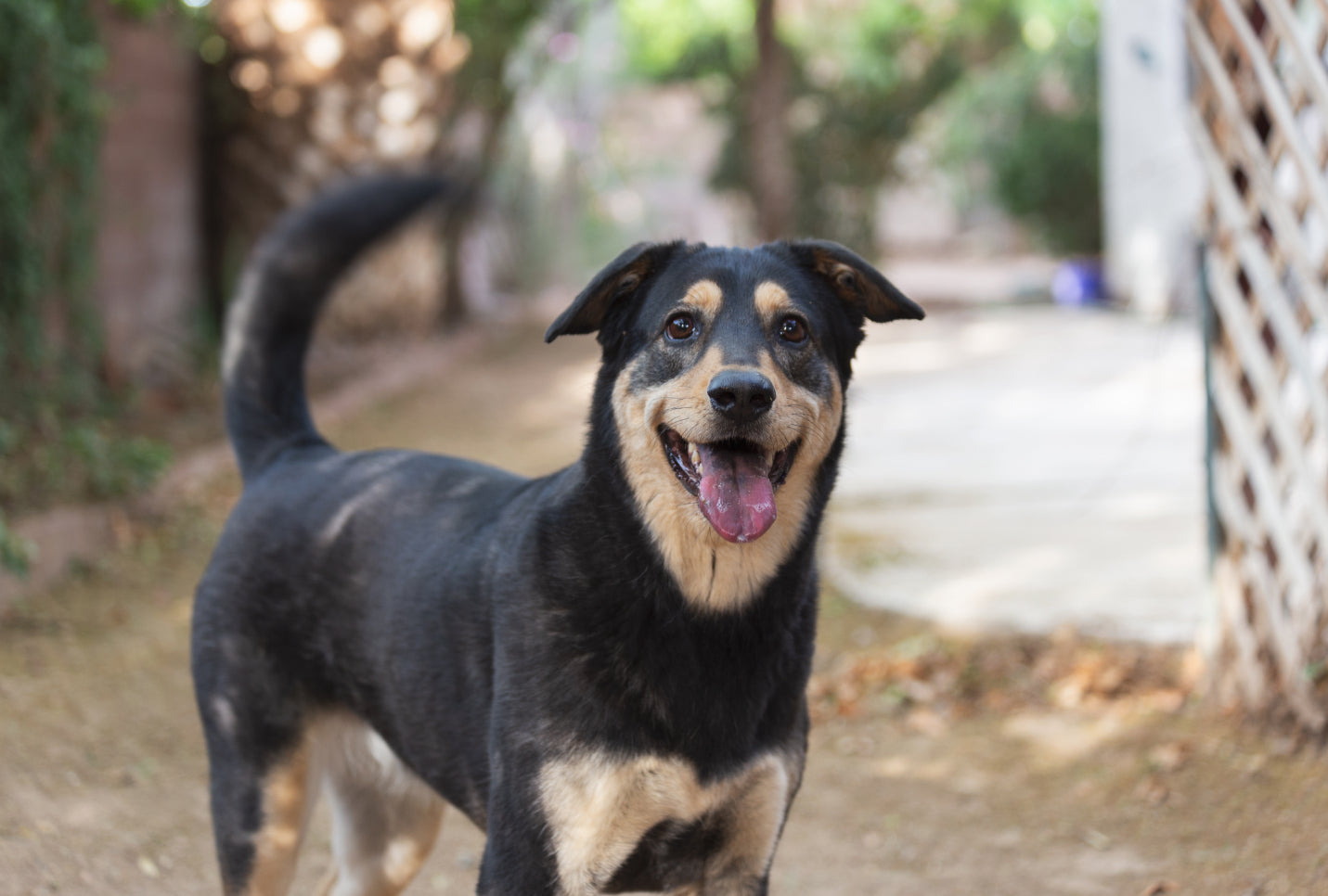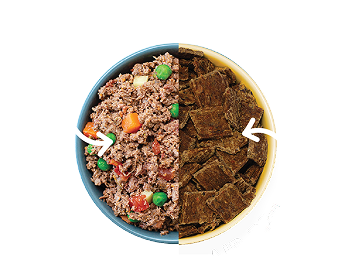
Why Do Dogs Wag Their Tails?
If you've ever found yourself mesmerized by the rhythmic swaying of a dog's tail from the right side to the left side, you're not alone. Tail wagging is a universal symbol of canine expression, conveying a multitude of emotions and intentions.
In this article, we'll unravel the secrets behind this delightful behavior, exploring the various meanings behind different tail wags and more. So if you're curious about the intricate language of dogs — keep reading.
The Science of Tail Wagging
It's widely known that humans use facial expressions to communicate with one another. Just as humans are equipped with the ability to express emotional responses through facial expressions, so too are dogs. In this case, however, emotion states are expressed through tail wagging.
Research suggests that tail wagging is a form of communication, with each direction and intensity conveying a unique message. The right hemisphere of the brain dictates tail wagging to the right side of the body, while the left hemisphere controls tail wags that go left.
And depending on which side of the brain is more active during any particular moment — so too will be the direction of tail-wagging. But tail wagging can mean both positive emotions and negative emotions.
Decoding the Different Tail Wags
So, what do different tail wags mean? Here's a quick overview of some common tail-wagging messages:
The Happy Tail Wag
When your happy dog greets you with a big, loose wag that sweeps from side to side, you can be sure they are thrilled to see you. This is the classic "I'm happy to be with you" wag, accompanied by a relaxed body and often a wagging rear end. It's a heartwarming sign of affection and excitement.
The Subtle Tail Wag
Sometimes dogs give a slight, low-intensity wag where their tail position barely moves. Don't be fooled, though! This can actually mean they are feeling a bit unsure or cautious.
It's their way of saying, "I'm interested, but I need a little more time to warm up."
The Alert Tail Wag
Imagine your dog's tail standing tall and rigid, wagging in short, quick movements. This wag indicates alertness and attention. They are fully aware of their surroundings and might be on the lookout for something interesting or exciting.
It's like their way of saying, "What's happening over there?"
The Playful Tail Wag
If your pup is in the mood for some fun, they might showcase an energetic and fast wag. This wag is usually accompanied by a bouncy body, a wagging rear end, and even some playful barks.
It's their way of inviting you or other dogs to join in on the playtime extravaganza.
The Nervous Tail Wag
When a dog feels anxious or uneasy, their tail may wag in a stiff and slow manner. It's as if their tail is saying, "I'm not entirely comfortable with this situation."
Pay attention to other body language cues to understand the context and help them feel more at ease.
The Submissive Tail Wag
In certain situations, especially when meeting new dogs or people they perceive as dominant, dogs may display a low and slow tail wag. It's their way of showing respect and submissiveness, indicating that they mean no harm and are not a threat.
The Content Tail Wag
Ever noticed your dog lying down, wagging their tail gently from side to side? This peaceful tail wag signals contentment and relaxation.
It's their way of saying, "Life is good, and I'm enjoying the moment."
Tails Aren't Just for Communication…
They're for balance too! Tail movement serves not only as a means of communication but also as an essential tool for maintaining balance. Just like a tightrope walker uses a pole to stay steady, dogs use their tails to help them navigate their surroundings precisely and gracefully.
But that's not all. Tails also provide a source of warmth and protection in cold weather, help with running and swimming, and even assist dogs during hunting activities such as digging and flushing out prey.
So, the next time you see your pup's tail in action, remember that it's as much about expressing emotion as it is about balance and precision.
Dog Waggin’ Tips
Now that we've dipped our toes in the fascinating world of tail wagging and its various meanings, let's explore some practical tips to enhance your understanding of your furry friend's communication and strengthen your bond even further.
Observe the Whole Body Language
While tail wagging is an important part of canine communication, it's essential to consider it alongside other body language cues. Pay attention to your dog's overall posture, facial expressions, ear position, and vocalizations. This holistic approach will give you a more accurate interpretation of their emotions and intentions.
Context Matters
Remember that the context in which a tail wag occurs can influence its meaning. For example, a dog wagging their tail during playtime has a different intention than when they wag it nervously during a vet visit. Take into account the situation, environment, and other factors to decipher the message behind the wag.
Respect Individual Differences
Just like humans, dogs have unique personalities and temperaments. Some may have more exaggerated or subtle tail wags, and their meanings can vary slightly.
Get to know your dog's specific tail-wagging patterns and understand their individual communication style. This personalized understanding will deepen your connection and facilitate effective communication.
Positive Reinforcement
When you observe a desirable tail wag that signifies happiness, excitement, or contentment, reinforce that positive behavior with praise, treats, or a handful of their favorite dog food. By associating the tail wag with a positive response, you encourage your dog to continue expressing those joyful emotions.
Consult a Professional
If you're uncertain about your dog's tail-wagging signals or need guidance in decoding their body language, don't hesitate to seek the help of a professional dog trainer or behaviorist. They can provide valuable insights and assist you in understanding and responding appropriately to your dog's communication cues.
How To Keep Your Pooch's Tail Wagging
Happy dog, happy life — here is some advice to help keep your pup's tail wagging:
Provide Ample Exercise
Regular exercise is crucial for a dog's physical and mental well-being. Engage in activities that match your dog's energy level and dog breed requirements. Whether it's brisk walks, games of fetch, or interactive play sessions, exercise helps release pent-up energy and keeps your pup content and wagging away.
Nourishing Diet
A balanced and nutritious diet plays a significant role in maintaining your dog's overall health and happiness. Consult your veterinarian to ensure you're providing the right food and portion sizes for your furry friend. A well-fed and satisfied dog is more likely to have a wagging tail.
Pro Tip: Support your pup with fresh, human-grade meals — A Pup Above is vet-approved, made with tasty ingredients (NO GMO), and is sure to get your pup's tail wagging!
Mental Stimulation
Dogs are intelligent creatures that thrive on mental stimulation. Provide interactive toys, puzzles, and training sessions to keep their minds engaged and active.
Mental stimulation not only prevents boredom but also promotes a sense of accomplishment and satisfaction, leading to wagging tails aplenty.
Socialize and Play
Dogs are social animals, and positive interactions with other dogs and humans contribute to their emotional well-being. Arrange playdates, visit dog parks, or enroll in training classes to give your pooch opportunities for socialization. Watching your dog wag their tail with excitement while engaging in joyful play is a delight like no other.
Quality Time and Affection
Dogs are loyal companions who crave your attention and affection. Set aside dedicated quality time each day to bond with your furry friend. Engage in activities they enjoy, such as belly rubs, grooming sessions, or simply relaxing together. The more love and attention you shower upon them, the happier their tails will wag.
Consistent Training
Training your dog provides them with structure, guidance, and a sense of accomplishment. Positive reinforcement training methods, such as rewarding good behavior with treats and praise, foster a positive environment and strengthen your bond. A well-trained dog feels confident and secure, resulting in a wagging tail that reflects their contentment.
Pro Tip: Don't have treats on hand? Use a handful of their favorite fresh dog food instead!
Health Care and Regular Check-ups
Keeping your dog in good health is essential for a wagging tail. Schedule regular veterinary check-ups to monitor their overall well-being, address any health concerns promptly, and ensure they're up-to-date on vaccinations and preventive care. A healthy dog is a happy dog with a tail that never stops wagging.
Conclusion
A dog's tail is an incredibly important tool for communication and expression. As dog owners, it's important to pay attention to our dogs' tail-wagging behavior to better understand their feelings. By observing their tail's speed, position, and movement, we can gain valuable insight into our canine friends and deepen our bond with them.
Here at A Pup Above, we believe in helping all pups lead happy, healthy lives — and that starts with a wagging tail. We provide delicious meals to nourish both body and mind because when tails wag, everyone wins!
Check us out today and experience the difference wholesome food and all-natural ingredients can make in your pup's life.
Sources:
From Head to Tail: The Language of Tail Wagging | FACE Foundation
Substrate use drives the macroevolution of mammalian tail length diversity | PMC
A Mentally Stimulated Dog Is a Happy Dog | American Kennel Club
Top Stories

Why Do Dogs Lick Their Paws?

Why Do Dogs Whimper & Make Noises in Their Sleep?

Healthy Vet-Approved Homemade Dog Food Recipes

How To Cook Sweet Potatoes for Dogs






















